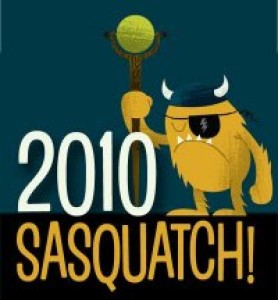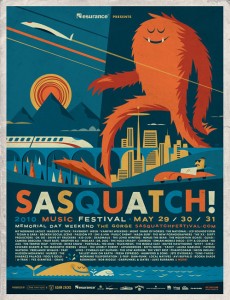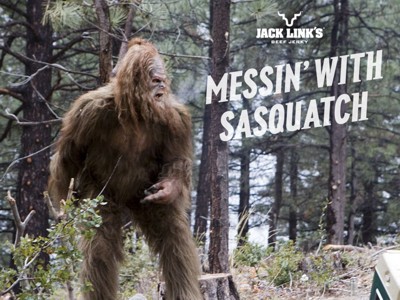The Ultimate Earth Day Icon: Sasquatch
Posted by: Loren Coleman on April 22nd, 2010
Today is the 40th anniversary of Earth Day.
Why haven’t Earth Day organizers utilized a group of natural wonders among us for the Earth Days’ benefit?
How long will it be before supporters of Earth Day realize that the ultimate Earth Day icon, mascot, and symbol of the underlying theme (“a day designed to inspire awareness and appreciation for the Earth’s environment”) is the Sasquatch – indeed, bands of Sasquatch, protecting the Earth?
Frankly, I think the “Bobby Bigfoot” notion misses the mark. Here’s that supposedly “kid-friendly” site’s message: “Hello Earth Day Network educator! I’m Bobbie Bigfoot here to present Earth Day Network’s new sustainability lesson plans. Sustainability is one of the most pressing environmental concerns of our lifetime – we cannot survive on Earth forever without creating a sustainable future!”

Someone has really missed the mark with the guilt-inducing “Adventures of Bobbie Bigfoot” campaign, where children are asked to think about their carbon and other terrible “footprints.”

What gives here? Who wants a preachy kid with $5 words telling you what Earth Day is about as your symbol?
When will Earth Day organizers look to the family bands of Sasquatch out there trying to survive in the environment for the logical icon? Actually, damn, Sasquatch are protectors of the environment, aren’t they?
The Earth needs warriors, as well as educators, but certainly not neurotic kids!!
It is time for the Sasquatch to be promoted as the ultimate Earth Day symbol.
They are both strong and people-friendly!! It has worked for other “products” ~ and messages!



After all, Sasquatch can be viewed as truly interested in the environment. Who wants to disagree with them about how important the Earth really is?

Furthermore, I am reminded of a quote from my late friend, anthropologist Carleton Coon, who was talking about Sasquatch, when he said:
“They are smarter than we are in the sense that they can live without modern inventions, in apparently every climate, even deserts, if the latter are within walking distances of mountains and water….If we don’t destroy the atmosphere, it may be they who have the better chance to survive , if it is true that the meek shall inherit the earth.”
This is from the paper (“Why There Has To Be A Sasquatch”) that Carleton S. Coon, Ph. D. delivered in May 1978 at the University of British Columbia’s Anthropology of the Unknown: Sasquatch and Similar Phenomena, a Conference on Humanoid Monsters.
Coon’s contribution was excluded from being published in the official proceedings of papers from that conference. However, it was later published (on pages 45-50) in The Sasquatch and Other Unknown Hominoids (1984), edited by Vladimir Markotic, Ph. D. and Grover Krantz, Ph. D.

About Loren Coleman
Loren Coleman is one of the world’s leading cryptozoologists, some say “the” leading living cryptozoologist. Certainly, he is acknowledged as the current living American researcher and writer who has most popularized cryptozoology in the late 20th and early 21st centuries.
Starting his fieldwork and investigations in 1960, after traveling and trekking extensively in pursuit of cryptozoological mysteries, Coleman began writing to share his experiences in 1969. An honorary member of Ivan T. Sanderson’s Society for the Investigation of the Unexplained in the 1970s, Coleman has been bestowed with similar honorary memberships of the North Idaho College Cryptozoology Club in 1983, and in subsequent years, that of the British Columbia Scientific Cryptozoology Club, CryptoSafari International, and other international organizations. He was also a Life Member and Benefactor of the International Society of Cryptozoology (now-defunct).
Loren Coleman’s daily blog, as a member of the Cryptomundo Team, served as an ongoing avenue of communication for the ever-growing body of cryptozoo news from 2005 through 2013. He returned as an infrequent contributor beginning Halloween week of 2015.
Coleman is the founder in 2003, and current director of the International Cryptozoology Museum in Portland, Maine.










First off, that Bobbie Bigfoot mascot is HORRENDOUS; I feel that I may need to wash my eyes with bleach after staring at it for more than 2 seconds.
Secondly, I think a campaign to promote conservation utilizing Sasquatch is a fine idea. The kids are already familiar with some aspects of Bigfoot ‘thanks’ to pop culture; if the Big guy is used to sell stuff already, why not asking him to help us preserve the ecology?
The problem with these campaigns, as you stated, is that they tend to be preachy and aim at the guilt factor. There really have to be better ways to make people understand about our role as stewards of the planet.
Of course, we need to make people realize that by now it is kind of too late. Whether we like it or not, ALL OF US will experience the effects of climate change. All these campaigns should be aimed at trying to prevent the very nastier outcomes of it.
Priceless quote!
Persuasive, with the best of intentions, but I remain unconvinced. I’d prefer that sasquatch remain on the periphery of our cultural consciousness. It’s consistent with its presumed cryptic nature, which in turn reflects a kind of cryptic nature that is present in all of us. Having a sanctioned and approved design concept stand along with the panoply of pop-culture mascots like McGruff the crime fighting bloodhound, Woodsy Owl, Muffler Man, and the Stay Puff Marshmallow Man reduces it to just another madison avenue attempt at raising consciousness with some ulterior motive, usually involving the forwarding of some presumed plan, that in reality (at least as it applies to sasquatch) is better left alone, and as we see there really is no need to make it official as sasquatch continues to be appropriated by a wide, and increasingly broad, spectrum of users all of whom would no doubt like to claim exclusivity when it comes to sasquatch. I prefer it to remain free, unfettered, and curious. Cheerio.
Sasquatch and the Spotted Owl have a lot in common. They live in primeval Northwest oldgrowth forests and are an indicator species for that habitat. Sasquatch as an indicator species of healthy NW habitat may be more popular among loggers too 🙂
I am also reminded of the old Montana Bigfoot sighting in the Bitterroot mountains. A logger was out cutting trees and saw a Bigfoot looking at him. When he started up his chainsaw, the Bigfoot’s neck hair stuck out. When he stopped the chainsaw, the neck hair went down. Message? “No cut Bigfoot’s forest!”
And many tribes such as the Lakota and Blackfeet see the sightings of Bigfoot as a warning that things are getting bad, environmentally and other ways too.
Ape behaviorist Jane Goodall is a fan of bigfoot. She says that all culture all around the WORLD have at least one legend of a bigfoot, sasquatch, or ape-man. Food for thought.